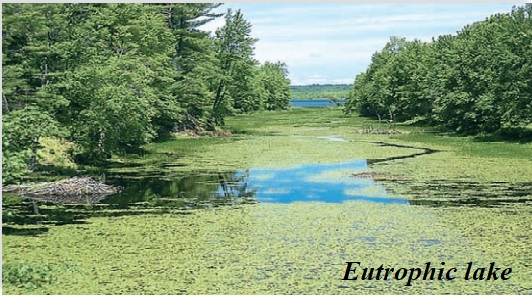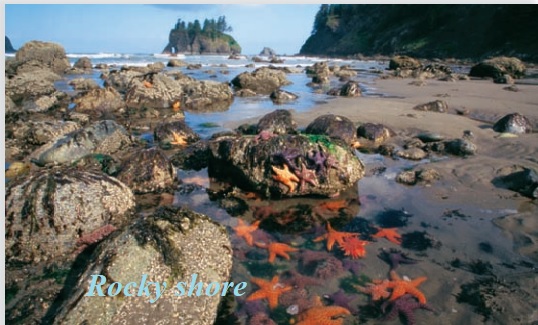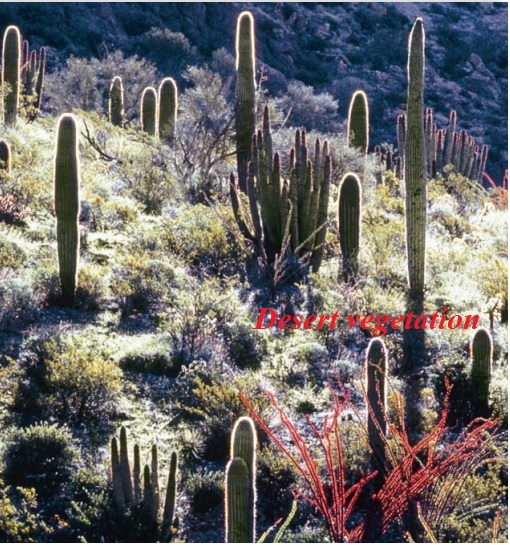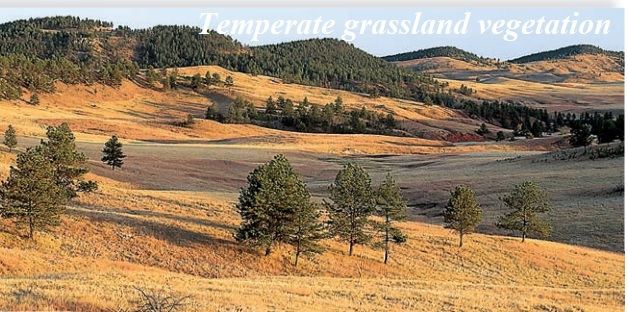Habitats and adaptation of organisms to their habitats.

Habitats and adaptation of organisms to their habitats.
What is a habitat?
A habitat is a particular place where a specie lives and reproduces is its habitat. The habitat might be the forest floor, a swift stream, or the ocean’s edge.
An ecological niche is the role a species plays in its community, including its habitat and its interactions with other organisms. The niche includes the resources used to meet energy, nutrient, and survival demands.
There are two main types of natural habitats;
- Aquatic habitat.
- Terrestrial habitat
Aquatic Habitat.
Aquatic habitats are classified into two types: freshwater (inland) or saltwater as well as brackish water which is a mixture of fresh and salt water.
Examples of aquatic habitats are ponds, lakes, streams and rivers, oceans, and seas.
Freshwater Habitat.
Lake and Pond
Lakes are bodies of fresh water often classified by their nutrient status.
Oligotrophic (nutrient-poor) lakes are characterized by a small amount of organic matter and low productivity. Their low productivity keeps the water crystal clear, making them popular recreational sites.

Eutrophic (nutrient-rich) lakes are characterized by plentiful organic matter and high productivity. Eutrophic lakes are often thick and “soupy” making them unattractive for recreation. Over long periods of time, as sediments accumulate, lakes naturally change from oligotrophic to eutrophic; their basins eventually fill with sediments, and terrestrial plants invade.
Oligotrophic lakes can become eutrophic through large inputs of nutrients. This process is called eutrophication.

Lake/pond may contain species with relative population sizes. It has three zones within which organisms occupy.
- Littoral zone: it is a shallow region where sunlight penetrates to the bottom. It is occupied by rooted plants, water boatman, plankton, microscopic algae, larvae, duckweed, etc.
- Benthic zone: this part is towards the bottom. This zone is beyond sunlight penetration. It is occupied by fish, shrimp, water fleas, etc.
- Muddy zone/bottom: it is an area where the water meets the ground. It is occupied by water snails, water lilies, leeches, dragonfly nymphs, etc.
The zones may also be classified as littoral zone, limnetic zone, and profundal zone
- limnetic zone forms the sunlit body of the lake, small fishes, such as minnows and killifish,
- profundal zone is below the level of light penetration. E.g., catfish, whitefish, Crayfishes, and molluscs (see art).
Adaptations of organisms to live in ponds and lake
- Vacuoles containing gas in many blue-green bacteria and oil stored in diatom enable these organisms to float on the water surface
- Some have large air space in their roots and leaves which support them float on the surface of water e.g., Pistia and Lemna
- Pond and lake plants have stomata only on the upper surface of the leaves and their cuticles are either waxy or covered with hairs to discourage water from blocking the stomata
- Some insects here have springtails and water-repelling bristles that enable them to stay on water surface e.g., Gerris (Pond skaters)
- Presence of spiracles and siphons for gaseous exchange e.g., pond skaters, mosquito larvae, and pupae respectively
- Some pond and lake plants have finely divided, thin leaves with no roots enabling them to float freely on surfaces of water e.g., Ceratophyllum
- Some have roots to the shallow bottom of the water and their leaves are long, flat, and thin giving them a larger surface area for maximum absorption of carbon (iv) oxide, and oxygen
- Presence of gills and swim bladder in some animals for breathing and being able to rest at any depth in water e.g., tilapia, Clarias (catfish)
Streams and rivers
Water is constantly moving and very often, conditions keep on changing e.g., when water falls heavily, the nutrients is been washed into streams and rivers and they also flow faster and turbidity also increases.
- Organisms living in streams and rivers tend being carried away by water currents.
- Organisms in streams and rivers either swim or adapt to this challenge.
- Some hide among the vegetation at the river bank where the water moves slowly. E.g., limpets
- Others attach themselves to the rocks and stones inside the water bodies e.g., the larva of blackfly.
Adaptations of plants to freshwater habitat (hydrophytes)
- they have large air spaces in leaves, stems for floating or buoyancy
- stomata on the upper surface of leaves for gaseous exchange
- waxy upper cuticle for repelling water droplets
- flowers are raised above the water surface for pollination
- leaves with a large surface area for maximum light absorption
- possession of soft or flexible stem of submerged plants which withstands the water currents
- Long petiole to support and expose the broad lamina for photosynthesis
- small size of plant for buoyancy
- submerged plants have thin cuticles permeable to water and mineral salts. e.g., water lily, elodea, lemna, Pistia, water lettuce,
Structural features which adapt animals to aquatic life
- Possession of gills/respiratory trumpet for gaseous exchange
- Presence of swim bladder for buoyancy
- Streamlined body for easy movement
- Lateral line for detection of vibration
- Fins/swimmerets/webbed digits for movement
- Suckers/hairs for attachment onto vegetation to prevent being swept away
Brackish Water
- Its salinity is between that of fresh water and sea water e.g., lagoon and estuarine
- Tide level fluctuate
- Organisms living in brackish water can tolerate variations in concentration of their body fluids e.g., crabs, bivalves, mudskipper, mangrove plant etc.
Marine
- Marine consist of oceans and
- It has a high salinity
- Organisms that live in marine environment can tolerate a high concentration of salt e.g., herrings and tuna
it has three zones; land, intertidal zone and the sea
- intertidal zone is the zone between the water mark at low tide and high tide. some organisms that dwell at the intertidal zone include limpets, ghost crabs, mussels, barnacles, algae (sea lettuce and Sargassum).
Adaptations of organisms to seashore life (marine)
- some of the organisms has the ability to dig into the sand and others withdraw into their holes to avoid predation e.g., starfish (Astropecten), molluscs(Terebra, Donax)
- some avoid drying up by withdrawing into protective shell and enclosing some water with them e.g., limpets and barnacles
- some use their foot to attach to rocks by suction, others secret cemented elements for attachment e.g., limpets and barnacles
- crabs have flattened bodies that allow them to move into rock crevices
- some have holdfast for attachment onto rocks permanently e.g., green sea lettuce Ulva and brown algae Dictyopteris and Sargassum.


Terrestrial habitat
- Terrestrial habitats are categorized according to the type of vegetation
- It is categorized into forest, grasslands (savanna) and deserts
- The distribution of animals in these habitats depend on the kind of vegetation
Tropical forest
Tropical forest occurs in equatorial and subequatorial regions.
In tropical rain forests, rainfall is relatively constant, about 200–400 cm annually.
In tropical dry forests, precipitation is highly seasonal, about 150–200 cm annually, with a six- to seven-month dry season.
Temperature High year-round, averaging 25–29°C with little seasonal variation.
- In a tropical rainforest, rain falls all year round
- The most abundant plants in a rain forest are trees
- Other smaller plants include, seedlings of trees, shrubs, herbs and ferns.
Nature of plants found in the tropical forests
Tropical forests are vertically layered, and competition for light is intense.
Layers in rain forests include trees that grow above a closed canopy, the canopy trees, one or two layers of subcanopy trees, and layers of shrubs and herbs (small, nonwoody plants).
There are generally fewer layers in tropical dry forests.
Broadleaf evergreen trees are dominant in tropical rain forests, whereas many tropical dry forest trees drop their leaves during the dry season.
Epiphytes such as bromeliads and orchids generally cover tropical forest trees but are less abundant in dry forests.
Thorny shrubs and succulent plants are common in some tropical dry forests
Epiphytes are also found in rainforests
Epiphytes are plants that grow on and supported by other plants without taking any food nutrients from the other plant.
Climbing plants are also found in a rain forest
- The branches and leave of the tall trees form a canopy
- The canopy provides shade for other organisms’ examples of animals living in rain forests are tortoise, snakes (vipers), dulker, mice, rats etc.
- Some animals live in the trees and are referred to as arboreal, e.g., grasshoppers, butterflies, ants, spiders, tree frogs, chameleons, snakes (green mamba), parrots, owl, bats, monkeys etc.
Adaptations of trees in the tropical rain forest
- Trees have broad leaves to enhance water loss through transpiration
- Trees have thin and smooth barks which facilitate water loss through transpiration
- Trees have buttress roots to provide extra support
- Trees are tall and unbranched to compete for adequate sunlight
- Tree leaves have drip tips for water loss through transpiration
Nature of animals found in the tropical forests
Earth’s tropical forests are home to millions of species, including an estimated 5–30 million still undescribed species of insects, spiders, and other arthropods.
In fact, animal diversity is higher in tropical forests than in any other terrestrial biome.
The animals, including amphibians, birds and other reptiles, mammals, and arthropods, are adapted to the vertically layered environment and are often inconspicuous.
Adaptations of animals in tropical rain forest
- Animals have opposable digits for climbing and grasping
- Animals have tail for extra support when climbing
- Some animals have grasping scales for climbing
- Animals have sharp claws for climbing
- Presence of patagium for gliding on trees. E.g., bats
- Presence of expanded ribs for climbing
- Exhibits binocular vision for judging distances accurately
Savanna

Savanna is mainly grassland, having smaller trees and shrubs.
The savanna experiences little rainfall all year round
In west Africa, the savanna is divided into three
- Guinea savanna – relatively humid
- Sudan savanna – less humid
- Sahel savanna – relatively dry
There is an increase in drought (decrease in rainfall) as you move from one zone to another (south to north)
- Plants found in this habitat are mostly annuals and perennials.
- Annuals are plants that complete their life cycle in one growing season (from germination to death) e.g., maize, rice, sunflower etc. whilst perennials are plants that continue to grow for several years, producing fruits and seed in most seasons. e.g., Terminalia, Acacia, Shear nut.
- Most savanna plants are fire resistant
- Most savanna animals are herbivores and a few are carnivores e.g., mice, squirrels, antelopes, giraffes, zebras, elephants, monkeys, lions and cheetahs
- Others feed on carcass e.g., hyenas and vultures
- Birds like pigeons, cattle egret, insects like grasshoppers and termites, reptiles like cobra, lizards and chameleons all live in savannas
Structural features of animals for adaptation to terrestrial habitat
- Dry scaly skin/thick skin/cuticles to reduce water loss and prevent injury
- Possession of hairs/feathers for temperature regulation
- Lungs for gaseous exchange
- Sweat glands in mammals for cooling/excretion.
Chaparral

This biome occurs in midlatitude coastal regions on several continents, and its many names reflect its far-flung distribution:
- chaparral in North America,
- matorral in Spain and Chile,
- garigue and maquis in southern France,
- fynbos in South Africa.
Precipitation is highly seasonal, with rainy winters and dry summers.
Annual precipitation generally falls within the range of 30–50 cm.
Temperature fall, winter, and spring are cool, with average temperatures in the range of 10–12°C.
Average summer temperature can reach 30°C, and daytime maximum temperature can exceed 40°C.
Plants
This habitat is dominated by shrubs and small trees, along with many kinds of grasses and herbs.
Plant diversity is high, with many species confined to a specific, relatively small geographic area.
Adaptations of the woody plants to drought include their tough evergreen leaves, which reduce water loss.
Adaptations to fire are also prominent.
Some of the shrubs produce seeds that will germinate only after a hot fire
Food reserves stored in their fire-resistant roots enable them to resprout quickly and use nutrients released by the fire.
Animals
Native mammals include browsers, such as deer and goats, that feed on twigs and buds of woody vegetation, and a high diversity of small mammals.
Chaparral areas also support many species of amphibians, birds and other reptiles, and insects.
Desert
 Desert is a terrestrial habitat that experience long periods of drought. It is also characterized by wind, low humidity and high temperature.
Desert is a terrestrial habitat that experience long periods of drought. It is also characterized by wind, low humidity and high temperature.
Deserts are noted for extremely hot days and extremely cold nights.
Organisms that survive in deserts are those that are adapted for water storage e.g., cactus, euphorbia, camels etc.
Deserts occur in bands near 30° north and south latitude or at other latitudes in the interior of continents.
Plants vegetation found in desert
Deserts are dominated by low, widely scattered vegetation.
The proportion of bare ground is high compared with other biomes.
The plants include succulents such as cacti or euphorbs, deeply rooted shrubs, and herbs that grow during the infrequent moist periods.
Desert plant adaptations include tolerance of heat and dessication, water storage, and reduced leaf surface area.
Physical defenses, such as spines, and chemical defenses, such as toxins in the leaves of shrubs, are common.
Many of the plants exhibit C4 or CAM photosynthesis.
Adaptations of plants to dry terrestrial habitats (xerophytes)
- They have deep seated roots (taproot) for tapping water from the soil
- Succulent leaves or stem for water storage
- Modified leaves into spines or scales-like structure for reduction in water loss
- Presence of thick waxy cuticle or hairs on leave to reduce water loss
- Rolling of leaves or sunken stomata to reduce water loss
- Thick bark for fire resistance
- Plants with life cycle to survive unfavourable conditions
- Seasonal shedding of leaves to reduce water loss e.g., Cactus, Euphorbia, Acacia, Baobab, Bryophyllum, Casuarina, Aloe
Animals found in desert.
Common desert animals include snakes and lizards, scorpions, ants, beetles, migratory and resident birds, and seed-eating rodents.
Many species are nocturnal.
Water conservation is a common adaptation, with some species surviving solely on water obtained from breaking down carbohydrates in seeds.
Adaptations of animals to desert life
- Small mammals burrow to avoid extreme heat
- Some are active in the morning and evening to avoid extreme heat within the day e.g., reptiles,
- Production of concentrated urine to conserve water within the body
- Developed structures (humps) to store fats that can be metabolized to provide energy/food and oval blood cells for water conservation e.g., camel.
Temperate Grasslands
The temperate grasslands include the Russian steppes, the South American pampas, and the North American prairies.
Precipitation is often highly seasonal, with relatively dry winters and wet summers.
Annual precipitation generally averages between 30 and 100 cm.
Periodic drought is common.
Winters are generally cold, with average temperatures falling below –10°C.
Summers, with average temperatures often approaching 30°C, are hot.
Plants and animals in temperate grasslands
The dominant plants are grasses and forbs, which vary in height from a few centimeters to 2 m in tallgrass prairie.
Many grassland plants have adaptations that help them survive periodic, protracted droughts and fire.
For example, grasses can sprout quickly following fire.
Grazing by large mammals helps prevent establishment of woody shrubs and trees.
Now, small mammals, such as mice, prairie dogs, and rabbits, typically live belowground, but usually feed aboveground.
Hawks, snakes, badgers, coyotes, and foxes feed on these mammals.
Virtually most of these grasslands, however, have been converted to agricultural lands because of their fertile soils.

TEST YOUR KNOWLEDGE





